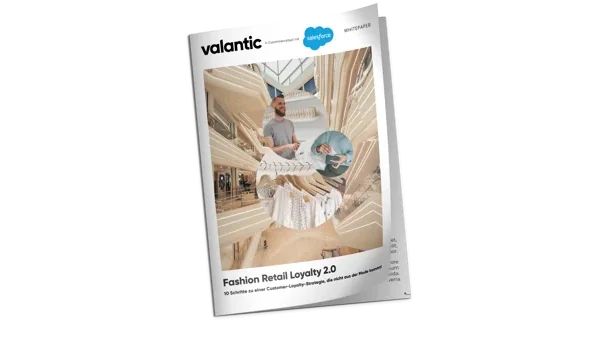From idea to strategy: the conception of a loyalty program
May 14, 2024

May 14, 2024

Designing a loyalty program in fashion retail is an art that requires strategic thinking and creative planning. In the second part of our comprehensive blog series, we explore the question of how a mature, strategic concept emerges from an initial idea. We look at the key steps from setting precise objectives to carefully selecting rewards triggers and developing an effective rewards structure to create a loyalty program that delivers real value for customers and the brand.
After discussing the basics of customer loyalty in the first part, we will now dive deeper into the planning and design of effective loyalty strategies that are specifically tailored to the requirements and challenges of fashion retail.
Defining clear goals is the critical starting point for any effective loyalty program in fashion retail. Without a firm goal in mind, it is nearly impossible to develop an effective strategy and measure the success of the program. Data-driven analysis plays a central role in this, as it provides in-depth insights into customer needs and preferences. This information is essential to find the right answers to the key questions: WHAT do you want to achieve, HOW do you plan to implement it, and WHO is your target group?
Reward triggers play a crucial role in an effective loyalty program. They are the specific customer actions or behaviors that are rewarded to increase customer engagement and activity. These triggers are critical as they not only encourage immediate participation in the program but also establish sustainable, loyal behavior towards the brand. The added value of these triggers manifests itself in increased customer satisfaction and loyalty, which significantly supports a company’s long-term success.
Behavior-based triggers reward customers for specific actions that are directly related to their purchasing behavior. These are directly aimed at encouraging certain behaviors that are valuable to the company.
These triggers are effective because they have a direct influence on customer behavior and promote targeted interaction with the brand.
Non-behavioral triggers, on the other hand, are independent of direct customer behavior. They aim to create an emotional bond and increase customer appreciation.
Examples of this are:
This type of trigger strengthens the emotional connection to the brand and increases customer loyalty without the customer having to actively do anything.
In summary, both types of triggers offer a comprehensive approach to strengthening different aspects of the customer relationship. The targeted selection and combination of these triggers are crucial to creating a balanced and engaging loyalty program that promotes both immediate customer action and long-term customer loyalty.
Designing a well-thought-out reward structure is of strategic importance for any loyalty program. It forms the heart of the program by creating incentives for customers to actively and continuously engage. A well-designed reward structure increases customer loyalty, promotes brand awareness, and contributes significantly to business success.
Identifying the optimal benefits of a loyalty program starts with a deep understanding of customer needs and preferences. It is essential to select benefits that offer high-added value for the customer but are also cost-efficient for the company. The sweet spot between these two aspects is the key to success.
In practice, it is important to balance these different types of benefits to cover a wide range of customer needs and enable a differentiated customer approach. The mix of monetary, service-based, and experiential benefits offers the opportunity to create a multi-layered and engaging loyalty program that appeals to customers on different levels and encourages long-term loyalty.

Ensuring the profitability of a loyalty program is a key aspect of its long-term success. An economically efficient strategy should achieve a clear return on investment (ROI) by increasing customer loyalty and sales without incurring disproportionately high costs.
One thing is certain: a loyalty program must be profitable. This means that the additional revenue generated by the program should exceed the costs of implementing and maintaining the program. A well-designed program can contribute significantly to increasing sales and at the same time strengthen customer loyalty and brand loyalty.
The loyalty margin refers to the difference between the value of the rewards for customers and the associated costs for the company. In fashion retail, for example, merchandise items or the co-determination of new collections as rewards are cost-efficient. It is important to find the balance between maximum customer-added value and minimum rewards costs to make the margin profitable.
Another important factor is the additional turnover generated. The program must generate more sales than it costs the company. Profitability is measured by comparing the additional expenditure of participants in the loyalty program with a control group that does not participate. This difference results in additional turnover.
Finally, healthy scaling of the program is important. In the initial and test phase, it is recommended to start with a Minimum Viable Product (MVP) to control the reach and scale of the program. This makes it possible to optimize the structure of the program before it is fully scaled. Gradual scaling helps to maintain the profitability of the program at all times and minimize risks.
Choosing the right design for a loyalty program is crucial to effectively address the different needs and preferences of customers. Through diversity in design, a program can be tailored to achieve maximum customer loyalty and brand loyalty.
Here is an overview of the most important forms of design:
Would you like to continue reading? Then don’t miss our next post in the blog series, in which we discuss the implementation of loyalty programs in detail.

Deepen your knowledge: Exclusive whitepaper on customer loyalty in fashion retail
We offer you access to our comprehensive whitepaper, which provides deep insights and extensive analysis in this area. A valuable resource for anyone looking to expand their knowledge!
Don't miss a thing.
Subscribe to our latest blog articles.